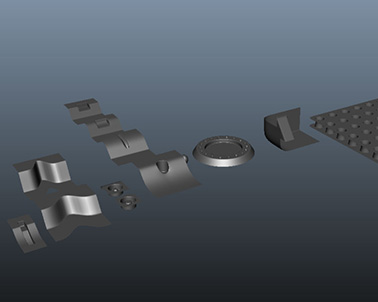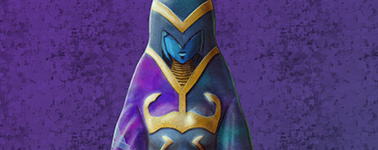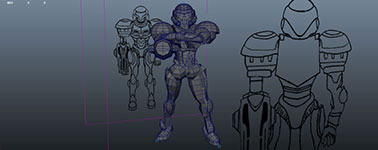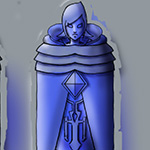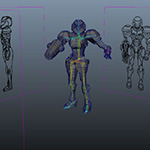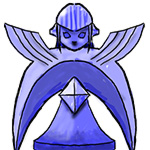Added Tuesday, November 20th, 2012 @ 12:00 AM
Part of my duties for The Network was to create preliminary environmental concept pieces that we could use in the Final Pitch presentation and that would help future artists have a place to start working from if the game went through the pitch. When I thought about the game’s environment, I thought about lots of buildings that were close together (so players could jump from rooftop to rooftop) with slightly varying heights and one or more areas with much taller buildings, similar to the environment in Mirror’s Edge. I didn’t need anything incredibly detailed, just a way to convey the ideas I had for the environment visually. I figured it would be faster and easier to create something like this in Maya, and rather than creating it by scratch (make a cube, move it, stretch it out, and repeat hundreds of times), I could write a script to do it for me! Plus, I might be able to use the script to help with this idea I had in the back of my head about randomly generating whole/parts of environments in the game.
I set out writing the script in MEL. Really, it just needed to do what I explained above–create a cube, move it, and stretch it vertically–a certain number of times within a certain area. It wasn’t complicated, but it was fast. The results were fantastic, and I could iterate outrageously fast. Obviously, it’s just a bunch of boxes, but it created pretty much the exact effect I was trying to achieve.
With the script, I could designate an area for buildings (cubes) to be populated, and give them a range of potential heights. I could also designate an area for taller buildings, which in my mind would be the “downtown”/more wealthy area of the city, as well as control the height ranges of those buildings. In a few of the tests I did, I ran the script more than once in the same area to 1) give more of a range in heights (which, fictionally, would be different districts) and 2) to have more than one downtown area in a city. I also tried applying some ambient occlusion to a few of them, just so I could see if the effect added anything and also to see how plausible it would be to apply it to that many polygons.
Added Monday, November 19th, 2012 @ 12:01 AM
Class:
PIE 1 Art- Modeling
Assignment:
This assignment will focus on hard surface modeling. You will be given a number of shapes in a Maya scene. Recreate those shapes using hard surface modeling techniques. In addition, begin converting your low res Samus redesign model to a hard surface, high res mesh. You are only required to model around 1/4 of the entire body for this assignment so that you can focus on getting the hard surfaces to work and look right. You will ultimately be using this high res model to create a normal map for your low res model. Since this high res model would not actually be used in a game (and we’re just creating it to get a normal map), there is no tri limit.
Description:
Hard surface modeling is essentially making a model more detailed while having both smooth, curved surfaces AND hard, sharp surfaces. Hopefully the first few images will give you an idea of what that looks like. We modeled the practice shapes so we could get a feel of the techniques for hard surface modeling before we started converting our Samus models to high res. Most of it was accomplished by placing edges close to one another so that when the model was smoothed, the curves would be dampened or negated completely, unless we wanted more curved parts in which case less edges were used. I’ve included screenshots of the models both smoothed and unsmoothed, so hopefully looking at both will give a feel for how the geometry controls what the models look like smoothed.
As far as the Samus model, I just took the original top half I modeled for the previous assignments and went to town adding geometry, smoothing things out, and making it more detailed all around.
The “revisions” mentioned in the image descriptions refer to the numbered save files I have for each model. For example, I have four different files, each being more complete than the last, with the fouth being the final model that I turned in.
Tris: 6,284
Added Thursday, November 15th, 2012 @ 12:00 AM
Class:
PIE 1 Art- Concept Art
Assignment:
Use one of your top three winning character redesigns from the previous assignment and create eight variations on that design. You may use your the winning redesign from the previous assignment as one of the eight for this assignment. Do not worry about color yet, but do use both varying value ranges and shading in your redesigns.
Votes of 18 students from previous assignment (design – number of votes):
Design 01 – 0
Design 02 – 6
Design 03 – 2
Design 04 – 1
Design 05 – 3
Design 06 – 5 (I voted for this one)
Design 07 – 0
Design 08 – 0
Description:
As you can see, design 02 was the winning redesign from the previous assignment. The first thing I did was take the outline out of Photoshop and into Illustrator to get some nice, clean, symmetric lines. I then took it back into Photoshop and colored the bajeebas out of it. I also used a few filters to try to mimic Skyward Sword’s style.
My aim was to design a slightly older looking Fi with an outfit using different parts of the Master Sword and its sheath. In addition, I also wanted her to be recognizable as Fi, so I used some of her original outfit’s elements, most noticeably its colors and the pattern on her legs (now on her arms :P).
Finally, we printed our designs out and hung them up.
Added Monday, November 12th, 2012 @ 12:00 AM
Class:
PIE 1 Art- Modeling
Assignment:
Continue working on your Samus model from the previous assignment. This is still a low res model you’re making. Again, when you’re done modeling, bind the model to a skeleton and make sure everything moves correctly. Use between 4,000 and 5,000 tris.
Description:
As you can see, I added some more detail to the model while at the same time getting rid of some unnecessary geometry (such as all those edges in the hand). I did a lot of work on the entire body, but most noticeable is probably the head, arm/hand, and the chest piece.
The “revisions” mentioned in the image descriptions refer to the numbered save files I have for each model. For example, I have eight different files, each being more complete than the last, with the eighth being the final model that I turned in.
Tris: 4,926
Added Monday, November 12th, 2012 @ 12:00 AM
Class:
Rapid Prototype Production (RPP) 1
Game:
Antivirus
Assignment:
You will be split into teams of 4-5 consisting of producers, programmers, and artists. In two weeks, create a social and/or mobile game. You can develop for Facebook and/or a mobile device.
Description:
Antivirus is a social, top down space shooter designed for playing on Facebook (it is no longer on Facebook). Players take control of an antivirus program that’s out to rid the digital world of viruses and malware. Players move around a confined environment shooting enemy programs while dodging attacks from said programs and trying to protect their own bits from becoming infected. Bits act like the player’s lives. Normally, bits follow the player around the field, but when they or the player gets hit by an enemy attack, they become infected, stop following the player, and begin shooting at him/her along with the enemies. Healthy bits randomly appear around the field, and can be picked up by the player before they’re hit by an enemy attack (and become infected). When the player runs out of healthy bits, the next shot to hit the player kills him/her and ends the game.
Enemies appear in waves. A certain number of enemies appear each wave, and when players eliminate the enemies from one wave, the next wave begins. There are three waves per level and five levels before the game is complete. Even if players don’t reach the end of the game, their scores are recorded.
On the social side of the game, players can could compare their high scores to those of their friends. The game also includes a level builder of sorts where players can designate how hard each wave of their “custom game” is. These custom games can then be sent to friends for them to play. While one may think that creating harder waves are the way to go, keep in mind that the harder the wave, the more points a player gets when playing/beating the wave. The scores of these custom games were also recorded and compared to friends’.
Credits:
Artist – Adam Grayson
Producers – Ben Crocker and Paul Weiler
Programmer – Laura Barton
Added Friday, November 9th, 2012 @ 12:00 AM
Class:
PIE 1 Art- Life Drawing
Description:
These are all of my drawings from our life drawing class, held every Friday. The course was heavy on anatomy. Each week we would focus on a different part of the body. Often we were instructed to pay attention to not the exterior curves of the body but rather the interior bones and muscles that created the exterior shape. The beginning of class was usually dedicated to techniques on how to draw the part(s) of the body we were focusing on that week while the rest of the class was series of timed drawings, again focusing on that week’s part(s) of the body.
All of these drawings are in Photoshop using a drawing tablet.
Added 11/9/12 @ 12:00 AM
Class:
PIE 1 Art- Concept Art
Assignment:
Use one of your top three winning character redesigns from the previous assignment and create eight variations on that design. You may use your the winning redesign from the previous assignment as one of the eight for this assignment. Do not worry about color yet, but do use both varying value ranges and shading in your redesigns.
Votes of 17 students from previous assignment (design – number of votes):
Design 01 – 2
Design 02 – 1
Design 03 – 5
Design 04 – 2
Design 05 – 3
Design 06 – 0
Design 07 – 0
Design 08 – 4 (I voted for this one)
Description:
Since design 03 was the winning redesign from the previous assignment, I used that as a base. Personally, I really liked 08 and 05, so I worked aspects of those into some of these redesigns. I was trying to go for a slightly older looking Fi with a different outfit than the original. Obviously I wanted her to be recognizable as Fi, so I kept some of the original outfit’s pieces like the jewel, her long, ribbon-like sleeves, and the criss-cross pattern on her legs, some of which I moved around. I also tried to introduce other aspects of the Master Sword and its sheath into her outfit.
I drew the redesigns in Photoshop and arranged them on a page. We printed our redesigns out (the last image below) and hung them up. Then we picked our one favorite redesign from each person’s work. The votes were tallied up, and whichever redesign got the most votes was the one we were to work on in the next assignment (in the case of a tie, the artist chose which one he/she wanted to work on). Which one do you like the best? 🙂
Added 11/8/12 @ 12:00 AM
Class:
PIE 1 Art- Animation
Assignment:
Create/Complete a set of controllers for the model we’ve been using in previous assignments. Movement of the model should be driven only from the controllers, NOT the joints. The rig should include forward kinematic controllers for everything but the legs which should be inverse kinematic controllers.
Take data from one of our motion capture shoots and bring it into Motion Builder. Apply one or more of the mocap motions to our model (in Motion Builder).
Create a MEL autorigging script that takes an .fbx exported from Motion Builder and applies our rig to it. The script should also remove keyframes from the joints of the .fbx and instead apply the keyframes to the rig’s controllers. This will allow the imported data to be driven solely by the controllers.
Description:
The video (Maya playblast) is just part of this assignment. At this point, my autorigging script was not complete, so that’s why there aren’t any controllers in the video. What this video DOES show is the Ganondorf model I’d been using applied to a mocap take. I applied the motion to the model in Motion Builder, and this video shows the result once I imported the skeleton and model back into Maya. Note that this is before any modifications from me. This is just the unedited data from the mocap shoot.
The images document the rig section of this assignment. The circles and arrows are FK controls, the boxes by the feet are IK controls, the L and R in front of the knees are pole vector controls, and the arrow in the back moves the entire model as a whole.
Fun fact: I was the actor for the mocap shoot 😀
Added 11/5/12 @ 12:00 AM
Class:
PIE 1 Art- Modeling
Assignment:
Choose one of the Samus redesigns from the eight provided, create a front, back, and side view from the original perspective, and use those as reference to create a low res, rough draft model in Maya. Stay between 3,000 and 4,000 tris. After you’re done modeling, make a skeleton to ensure that there are no glaring errors with the geometry and how it moves.
Description:
As you can see, I chose design 7. I thought that design looked the most like Samus–like that could be a design you’d see in the game–and because the suit looked more slender/feminine and was very different from all of the other bulkier, pointier options. Plus I thought the holes in the front were pretty cool.
I took the original perspective view created by our teacher, and I made the front, back, and side views in Photoshop. I then set those up as image planes in Maya and used them as reference while I modeled. After that, I built a quick skeleton to make sure all of the movement looked relatively believable (there were some issues there, but those were fixed in the next few assignments 😉 ).
The “revisions” mentioned in the image descriptions refer to the numbered save files I have for each model. For example, I have nine different files, each being more complete than the last, with the ninth being the final model that I turned in.
Tris: 3,916
Added 11/1/12 @ 12:00 AM
Class:
PIE 1 Art- Concept Art
Assignment:
Choose a character from the Mario, Metroid, or Zelda universe and redesign him or her. Create eight different thumbnails with varying value ranges. While these are redesigns, all eight designs must be recognizable as the original character.
Description:
Seeing as how I’m a diehard Nintendo fanboy, I had a hard time deciding which character to redesign. Seeing as how I’m a dieharder Zelda fanboy, I had an even harder time deciding which Zelda character to do (once I decided to choose a Zelda character :P). In the end, it was between Skyward Sword’s Zelda and Fi. As you can see, I chose Fi.
I drew the thumbnails in Photoshop and arranged them on a page. We printed our redesigns out (the last image below) and hung them up. Then we picked our three favorite redesigns from each person’s work. The votes were tallied up, and whichever redesigns got the most votes were the ones we could choose to work on in the next assignment (in the case of a tie, the artist chose which one he/she wanted to work on). Which ones do you like the best? 🙂
Added 10/30/12 @ 12:00 AM
Class:
PIE 1 Art- Modeling
Assignment:
Improve the Metroid environment from the previous three assignments.
Description:
I did pretty much everything to this–I reworked the model, tweaked the lighting, added to/changed the textures, and because of that, I had to rework some UVs. Though because getting the ambient occlusion bake to work correctly was such a pain in the previous assignment, I tried my hardest not to change the UVs too much.
As far as modeling, I went back in to remove lots of unnecessary geometry, I smoothed out some noticeably polygonal pieces (such as the middle circular pad), and I added a lot of small grooves and whatnot.
I did a little bit of rework with the lighting. Most obvious is the lighting coming from the central circular pad. I also added quite a bit of incandescence to the texture. At the teacher’s request, I removed the blast mark from the doors and I changed the screen on the main monitor in the middle. As you can see, I started to play around with (again) using sprites from the game, but the teacher asked me to remove those as well (I don’t remember exactly why).
Finally, I added Brawl’s Zero Suit Samus model into the environment (note, I did NOT make the model, but I rigged and posed it).
The “revisions” mentioned in the image descriptions refer to the numbered save files I have for each model. For example, I have 11 different files, each being more complete than the last, with the 11th being the final model that I turned in.
Tris: 15,312 (the tri limit was raised, but I don’t remember what to… 17,000 maybe?)
Maps: Color (2048×2048), Ambient Occlusion (2048×2048), Incandescence (2048×2048), Normal (2048×2048)






